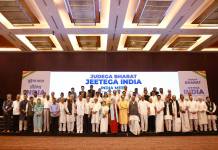It was the news agency PTI, which first reported that Chief Electoral Officer of Gujarat had accepted of a mismatch between the electronic count of votes and the paper count on at least four booths. No media outlets chose to highlight the stunning confession of BB Swain even when they carried the PTI news copy.
Instead, their identical headlines screamed that the vote count in EVMs had matched with VVPAT slips ‘100%.’It was the news agency PTI, which first reported that Chief Electoral Officer of Gujarat had accepted of a mismatch between the electronic count of votes and the paper count on at least four booths.
No media outlets chose to highlight the stunning confession of BB Swain even when they carried the PTI news copy. Instead, their identical headlines screamed that the vote count in EVMs had matched with VVPAT slips ‘100%.’
Since the Election Commission had chosen to pick one booth every constituency as a sample for matching the votes, it will be safe to conclude that the mismatch of votes on four booths should be deemed as mismatch of votes in that many assembly constituencies. The mismatch occurs when votes counted in EVMs do not tally with the votes counted using VVPAT paper print-outs.
The real extent of this mismatch can’t be verified because of the secrecy and non-transparency adopted by the EC with VVPAT verification processes. The EC was constitutionally duty bound to do such verification count in front of the candidates and counting agents before declaring the result.
The poll body, therefore, ought to come clean on whether it performed the random checks in Gujarat while adhering to constitutional norms.
When India introduced the VVPAT, the EC itself moored the idea of verifying 5% of machines. However, the Congress contested in the Supreme Court demanding the mandatory counting of VVPAT print-outs to be enhanced to 25%.
The apex court, as expected, decided not to interfere even as Janta Ka Reporter’s two-part expose added raised enough questions on the reliability of the voting machines.
What no one knows but they must know is whether the EC verified even those 5% machines in closed room after the results were declared?
Another important question that the EC must answer is if a digital transaction (voting in this case) in a machine can ever be different from the receipt? Numbers are unimportant but such mismatch in digital world is indicative of software glitches or bugs.
It is impossible to get a paper receipt of any electronic transaction which varies from the software programmed. Small discrepancies, howsoever small, is indicative of what came to be known in the West as “SALAMI FRAUD” existing within the software.
Salami Fraud was all about stealing small pennies from millions of accounts that became the most favourite and fraudulent method to siphon off millions of dollars without the account holders noticing the fraud.
EVMs through software manipulation is both capable of maximising the victory margins and minimising the losses within bounds of acceptable risk of detection. It is not unrealistic to imagine a systemic election rigging primarily to avoid one-sided or out of sync results that may make public at large utterly suspicious about the poll fraud.
To make even one-sided results look acceptable, you always have pliable TV channels and their dubious exit polls in India.
Let’s return to Gujarat
In Gujarat, there were over 16 seats, where the victory margins were less than 3,000 votes. A vote transfer of even half a percent in a constituency of two lakh voters could result in a victory of a candidate who was originally trailing by 2000 votes. Such minimalistic vote transfer could go undetected because the winner could always use power to block any efforts for rigorous verifications.
Election results through dishonest EVMs can potentially finish democracy by annihilating the more popular leaders. Many prominent leaders losing elections could be systematically weeding out a generation of political adversaries both within and outside their own parties. Governments elected through these illegitimate means can block any legitimate attempts to get the counting done through paper slips.
Hence the reluctance in returning to ballot papers. VVPAT machines are, therefore, a waste of time and money and have seemingly been introduced to legalise the process of dishonesty in our democracy.
Election theft through EVMs is fraud to nation
These thefts essentially allow the perpetrators in question to keep the process of “democracy” perfectly ‘intact’ even after it’s been effectively subverted. It is also something that very few Indians of our time never thought they’d have to worry about, and something that they’d still very much rather not worry about (as it goes against every premise of positive national identity and esteem).
In other words, we are in a very dark and dangerous place while staring at a historical tragedy in the making.
Apologists for the current computerised counting system will point to all the aspects of “openness:” how observers can be present at the polls, how the machines are “certified” and put through a sample ballot test at some point before the election, how with VVPAT, the voter gets to see a receipt! But mind you, that Paper Trail is not even good as toilet paper roll because it will never get to see the day light in counting room.
Germany ended electronic voting in 2009, with the German Federal Constitutional Court finding that the inability to have meaningful public scrutiny meant that the electronic voting was unconstitutional.
From the late 1990s until 2007, voting machines were used extensively in elections. Most areas in the Netherlands used electronic voting in polling places. On 5 October 2006 the group “Wij vertrouwenstemcomputers niet” (We do not trust voting machines) demonstrated on Dutch television how the Nedap ES3B machines could be manipulated in five minutes.
Unlike India they were not threatened with prosecution. Unlike India, their TV channels refused to crawl before the establishment and provided platform to the group challenging the reliability of voting machines.
After security problems with the machines were widely publicised, the Netherlands decided to ban in 2007.
EVM count mismatch: Salami Fraud in electoral system?
‘Salami Fraud’ is a term used to explain numerous large-scale and organised bank robbery through insidious hidden software that takes away tiny small pennies from millions of accounts to siphon off huge amount of money.
The account holders will never detect such fraud as the amount is really small. A more descriptive explanation of such frauds through software manipulation has been explained by one ME Kabay, Professor from Norwich University as follows:
“One type of computer crime that gets mentioned in introductory courses or in conversations among security experts is the Salami Fraud. In the salami technique, criminals steal money or resources a bit at a time. Two different etymologies are circulating about the origins of this term.
One school of security specialists claim that it refers to slicing the data thin – like a salami. Others argue that it means building up a significant object or amount from tiny scraps – like a salami. The classic story about a salami attack is the old “collect-the-roundoff” trick. In this scam, a programmer modifies the arithmetic routines such as interest computations.
Typically, the calculations are carried out to several decimal places beyond the customary 2 or 3 kept for financial records. For example, when currency is in dollars, the round-off goes up to the nearest penny about half the time and down the rest of the time. If the programmer arranges to collect these fractions of pennies in a separate account, a sizable fund can grow with no warning to the financial institution.
In Los Angeles in October 1998, the district attorneys charged four men with fraud for allegedly installing computer chips in gasoline pumps that cheated consumers by overstating the amounts pumped.
The problem came to light when an increasing number of consumers charged that they had been sold more gasoline than the capacity of their gas tanks. However, the fraud was difficult to prove initially because the perpetrators programmed the chips to deliver exactly the right amount of gasoline when asked for five- and ten-gallon amounts – precisely the amounts typically used by inspectors.
If more of us paid attention to anomalies, we’d be in better shape to fight the salami rogues. Computer systems are deterministic machines – at least where application programs are concerned.
Any error has a cause. Looking for the causes of discrepancies will seriously hamper the perpetrators of salami attacks. From a systems development standpoint, such scams reinforce the critical importance of sound quality assurance throughout the software development life cycle.
How to identify and avoid Salami Fraud of EVMs?
The surest way to detect the Salami Fraud in EVMs is to perform rigorous box testing by checking each and every line of code which is exhaustive but that’s the only way. However, the microchips of EVM is designed to conceal the written software from any honest or dishonest prying eye.
The only other method remains to detect the ‘Salami Fraud’ is to check stringently any mismatch between the paper count and electronic count. There could NEVER be any difference, howsoever small, in these two counts. Any mismatch will be indicative of theft in the system.
By not enforcing, 100% paper count to match electronic count, the Supreme Court has unwittingly contributed to the considerable erosion of public trust in the Indian democracy.
Dubious role of Delhi-based media
Delhi-based media, TV and print alike, is almost entirely a subsidiary of mega-corporations. Budgetary allocations for public-sprites journalism have been slashed to the bone, while opinions (often shouting competition) have replaced our reporting and investigation. Entertainment at any cost has become the order of the day.
That said, it is still astounding how impervious the Tv channels some usual suspects in print have been to this story. We have it, albeit off the record, from several top journalists that their employers have prohibited them from writing or speaking on the matter of computerised election theft or reviewing any of the evidence available in public domain.
In fact, the Indian press and media at large, are the most wretched villains of this real-life thriller at display in full force. Those actually doing the rigging, whether it’s a computer programmer sitting in America and playing God or some cadre of true believers, are in a sense “doing their job” with utmost sincerity.
The media’s job is to spot the foul, get to the bottom of it in a timeliness manner and report in public interest. Ironically, a vast majority of them are simply refusing to perform their duty. Both Individually and as a collective force they have served as conduits. They appear to be either in deep denial, anaesthetised, or content with a sham democracy, as long as it suits the financial interests of their ultimate corporate masters.
It is time journalists exhibited courage even if it meant risking his or her life, in service to the truth. After all, speaking truth to power has become a very costly exercise in India these days. Stakes were never so high in the past!
















